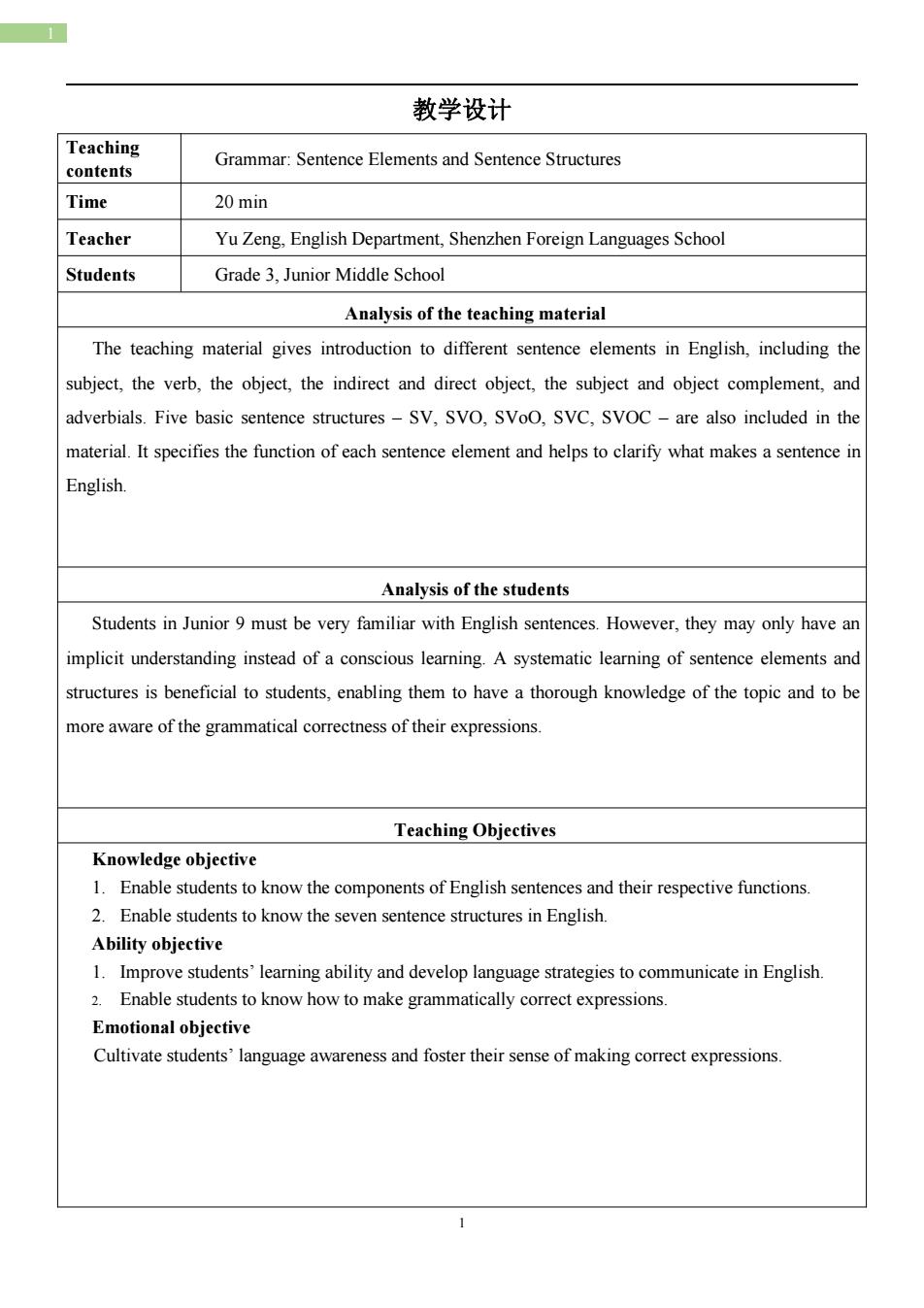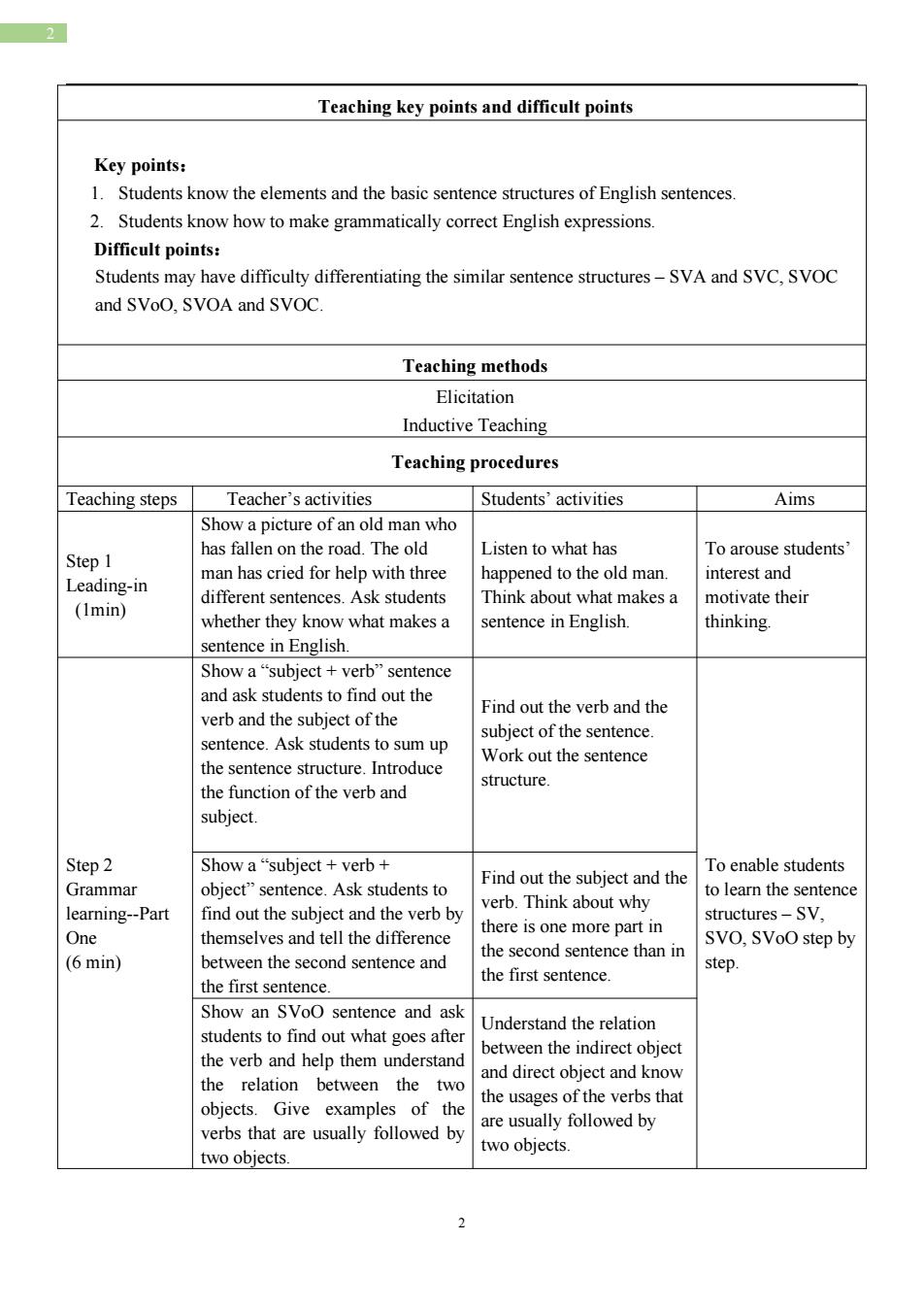
教学设计 Teaching Grammar:Sentence Elements and Sentence Structures contents Time 20 min Teacher Yu Zeng,English Department,Shenzhen Foreign Languages School Students Grade 3.Junior Middle School Analysis of the teaching material The teaching material gives introduction to different sentence elements in English,including the subject,the verb,the object,the indirect and direct object,the subject and object complement,and adverbials.Five basic sentence structures-SV,SVO,SVoO,SVC,SVOC-are also included in the material.It specifies the function of each sentence element and helps to clarify what makes a sentence in English. Analysis of the students Students in Junior 9 must be very familiar with English sentences.However,they may only have an implicit understanding instead of a conscious learning.A systematic learning of sentence elements and structures is beneficial to students,enabling them to have a thorough knowledge of the topic and to be more aware of the grammatical correctness of their expressions. Teaching Objectives Knowledge objective 1.Enable students to know the components of English sentences and their respective functions. 2.Enable students to know the seven sentence structures in English. Ability objective 1.Improve students'learning ability and develop language strategies to communicate in English. 2.Enable students to know how to make grammatically correct expressions. Emotional objective Cultivate students'language awareness and foster their sense of making correct expressions
1 1 教学设计 Teaching contents Grammar: Sentence Elements and Sentence Structures Time 20 min Teacher Yu Zeng, English Department, Shenzhen Foreign Languages School Students Grade 3, Junior Middle School Analysis of the teaching material The teaching material gives introduction to different sentence elements in English, including the subject, the verb, the object, the indirect and direct object, the subject and object complement, and adverbials. Five basic sentence structures – SV, SVO, SVoO, SVC, SVOC – are also included in the material. It specifies the function of each sentence element and helps to clarify what makes a sentence in English. Analysis of the students Students in Junior 9 must be very familiar with English sentences. However, they may only have an implicit understanding instead of a conscious learning. A systematic learning of sentence elements and structures is beneficial to students, enabling them to have a thorough knowledge of the topic and to be more aware of the grammatical correctness of their expressions. Teaching Objectives Knowledge objective 1. Enable students to know the components of English sentences and their respective functions. 2. Enable students to know the seven sentence structures in English. Ability objective 1. Improve students’ learning ability and develop language strategies to communicate in English. 2. Enable students to know how to make grammatically correct expressions. Emotional objective Cultivate students’ language awareness and foster their sense of making correct expressions

Teaching key points and difficult points Key points: 1.Students know the elements and the basic sentence structures of English sentences. 2.Students know how to make grammatically correct English expressions. Difficult points: Students may have difficulty differentiating the similar sentence structures-SVA and SVC,SVOC and SVoO.SVOA and SVOC. Teaching methods Elicitation Inductive Teaching Teaching procedures Teaching steps Teacher's activities Students'activities Aims Show a picture of an old man who has fallen on the road.The old Listen to what has Step 1 To arouse students' Leading-in man has cried for help with three happened to the old man. interest and different sentences.Ask students Think about what makes a motivate their (1min) whether they know what makes a sentence in English. thinking. sentence in English. Show a“subject+verb”sentence and ask students to find out the Find out the verb and the verb and the subject of the subject of the sentence. sentence.Ask students to sum up Work out the sentence the sentence structure.Introduce structure. the function of the verb and subject. Step2 Show a“subject+verb+ To enable students Find out the subject and the Grammar object"sentence.Ask students to to learn the sentence learning--Part find out the subject and the verb by verb.Think about why structures-SV, One themselves and tell the difference there is one more part in the second sentence than in SVO,SVoO step by (6 min) between the second sentence and step. the first sentence. the first sentence. Show an SVoO sentence and ask Understand the relation students to find out what goes after between the indirect object the verb and help them understand and direct object and know the relation between the two the usages of the verbs that objects.Give examples of the are usually followed by verbs that are usually followed by two objects. two objects. 2
2 2 Teaching key points and difficult points Key points: 1. Students know the elements and the basic sentence structures of English sentences. 2. Students know how to make grammatically correct English expressions. Difficult points: Students may have difficulty differentiating the similar sentence structures – SVA and SVC, SVOC and SVoO, SVOA and SVOC. Teaching methods Elicitation Inductive Teaching Teaching procedures Teaching steps Teacher’s activities Students’ activities Aims Step 1 Leading-in (1min) Show a picture of an old man who has fallen on the road. The old man has cried for help with three different sentences. Ask students whether they know what makes a sentence in English. Listen to what has happened to the old man. Think about what makes a sentence in English. To arouse students’ interest and motivate their thinking. Step 2 Grammar learning--Part One (6 min) Show a “subject + verb” sentence and ask students to find out the verb and the subject of the sentence. Ask students to sum up the sentence structure. Introduce the function of the verb and subject. Find out the verb and the subject of the sentence. Work out the sentence structure. To enable students to learn the sentence structures – SV, SVO, SVoO step by step. Show a “subject + verb + object” sentence. Ask students to find out the subject and the verb by themselves and tell the difference between the second sentence and the first sentence. Find out the subject and the verb. Think about why there is one more part in the second sentence than in the first sentence. Show an SVoO sentence and ask students to find out what goes after the verb and help them understand the relation between the two objects. Give examples of the verbs that are usually followed by two objects. Understand the relation between the indirect object and direct object and know the usages of the verbs that are usually followed by two objects

Quick summary.Summarize what Summarize what they have students have learned in Part One learned and complete the with a mind map. mind map. To clarify the Find out the difference function of Give a sentence of SVoO and a complement and sentence of SVOC and ask between SVoO and SVOC. and understand the deal with one of the students to compare them. function of complement. difficult points. Give a sentence of SVOC and Find out the difference To clarify the SVOA and ask students to tell the between complements and difference between Step 3 difference. adverbials. complements and Grammar adverbials and deal learning Give examples of different types Recognize adverbials in a with one of the --Part Two of adverbial. sentence. difficult points. (6 min) To clarify the difference between Give a sentence of SVA and a Think about the difference adverbials and sentence of SVC and ask students subject between an adverbial and a to tell the difference. complements and subject complement. deal with one of the difficult points. To enable students Step4 Guide students to complete a mind to have a clear Summary map about sentence elements and Complete the mind map. picture of what they (1 min) sentence structures. have learned in class. To check students' Ask students to tell the sentence Tell the sentence elements understanding of elements of the parts underlined in of the parts underlined in different sentence Step5 the sentences. the sentences. elements through Exercises the exercise. (5 min) Ask students to match the Analyze the structures of To check students' sentences with the sentence the sentences and tell the learning of sentence structures. structures. structures
3 3 Quick summary. Summarize what students have learned in Part One with a mind map. Summarize what they have learned and complete the mind map. Step 3 Grammar learning --Part Two (6 min) Give a sentence of SVoO and a sentence of SVOC and ask students to compare them. Find out the difference between SVoO and SVOC, and understand the function of complement. To clarify the function of complement and deal with one of the difficult points. Give a sentence of SVOC and SVOA and ask students to tell the difference. Give examples of different types of adverbial. Find out the difference between complements and adverbials. Recognize adverbials in a sentence. To clarify the difference between complements and adverbials and deal with one of the difficult points. Give a sentence of SVA and a sentence of SVC and ask students to tell the difference. Think about the difference between an adverbial and a subject complement. To clarify the difference between adverbials and subject complements and deal with one of the difficult points. Step 4 Summary (1 min) Guide students to complete a mind map about sentence elements and sentence structures. Complete the mind map. To enable students to have a clear picture of what they have learned in class. Step 5 Exercises (5 min) Ask students to tell the sentence elements of the parts underlined in the sentences. Tell the sentence elements of the parts underlined in the sentences. To check students’ understanding of different sentence elements through the exercise. Ask students to match the sentences with the sentence structures. Analyze the structures of the sentences and tell the structures. To check students’ learning of sentence structures

To help students enhance the Ask students to complete the Complete the sentences sentences with the preposition to knowledge of the structure or for. with a proper preposition. S+V+DO+to/for+I 0 To enable students Ask students to put the puzzles Play the jigsaw game and to apply what they into a correct sentence and choose have learned in tell the sentence structures the structure of the sentence. class to solve new problems. Homework 1.Review the lesson. 2.Finish the exercises on p54 in the textbook. 3.Make up a sentence for each of the seven sentence structures. Blackboard Design Sentence Elements and Sentence Structures Grammar Sentence structures:S+V Sentence elements:subject S+V+O object S+V+IO+DO/S+V+DO+to/for+IO indirect object S+V+O+C direct object S+V+O+A object complement S+V+A adverbial S+V+C subject complement
4 4 Ask students to complete the sentences with the preposition to or for. Complete the sentences with a proper preposition. To help students enhance the knowledge of the structure S+V+DO+to/for+I O. Ask students to put the puzzles into a correct sentence and choose the structure of the sentence. Play the jigsaw game and tell the sentence structures. To enable students to apply what they have learned in class to solve new problems. Homework 1. Review the lesson. 2. Finish the exercises on p54 in the textbook. 3. Make up a sentence for each of the seven sentence structures. Blackboard Design Sentence Elements and Sentence Structures Grammar Sentence structures: S+V S+V+O S+V+IO+DO/ S+V+DO+to/for+IO S+V+O+C S+V+O+A S+V+A S+V+C Sentence elements: subject object indirect object direct object object complement adverbial subject complement